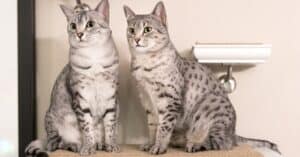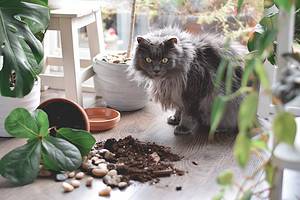Are you a cat lover but dread the idea of fur blanketing every surface of your home? Not to mention your clothes? Well, you’re not alone! Many prospective cat owners hesitate at the thought of endless grooming and vacuuming. While no cat breed is 100% hypoallergenic, some breeds are known to shed less, significantly reducing the chances of an allergic reaction. The less a cat sheds, the fewer allergens are present in your home, making your feline companionship more enjoyable and less sniffly. So, hope is not lost! There exists a variety of cat breeds that shed minimally or not at all, making them ideal companions for the allergy-prone or those who’d rather not spend extra time cleaning up fur.
In this article, we’ll explore 11 cat breeds that minimize the shedding dilemma while maximizing the cuddle sessions, bringing you the best of the feline world with fewer sneezes.
1. Siamese
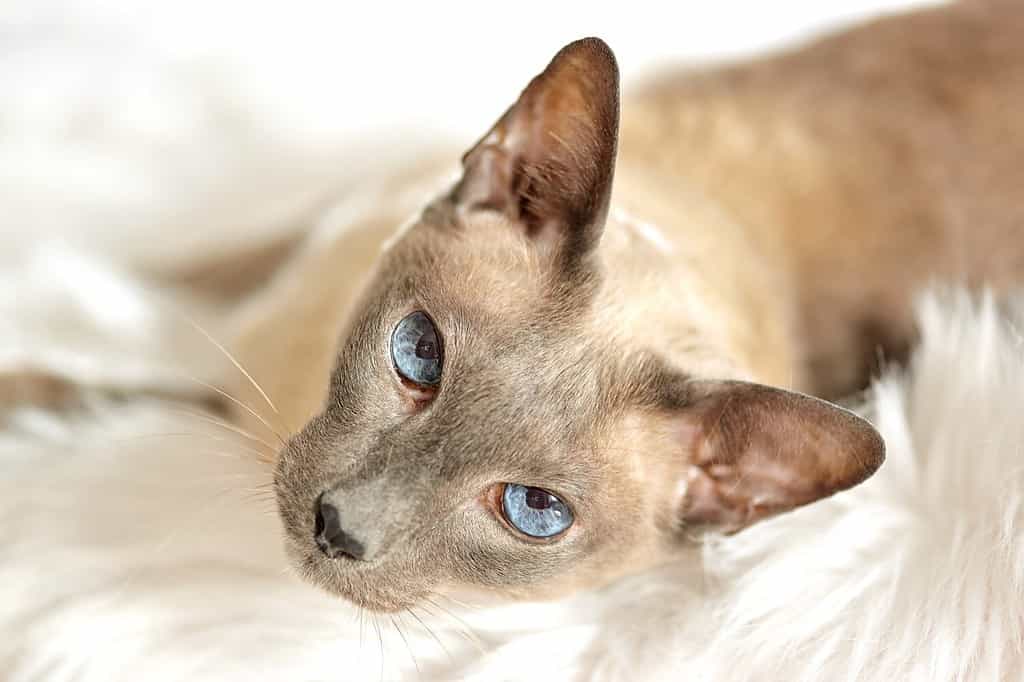
A famous cat breed that doesn’t or barely sheds is the Siamese.
©Chudo2307/Shutterstock.com
The Siamese cat is a breed native to Thailand. This breed is known for its striking appearance and engaging personality. A medium-sized cat breed, typically weighing between 8 to 15 pounds, the Siamese is recognized for its short, sleek coat. The Siamese comes in many different colors: seal, chocolate, blue, and lilac, which contrast beautifully with their piercing blue eyes.
When it comes to their fur, Siamese cats have short, smooth coats. They are known for shedding less compared to many other cat breeds. This lower tendency to shed is partly due to their short hair. This feature makes them require minimal grooming, which makes Siamese cats a relatively low-maintenance breed in terms of fur care.
While they do shed, especially during the fall and spring seasons, many Siamese cat owners find the shedding less noticeable.
2. British Shorthair
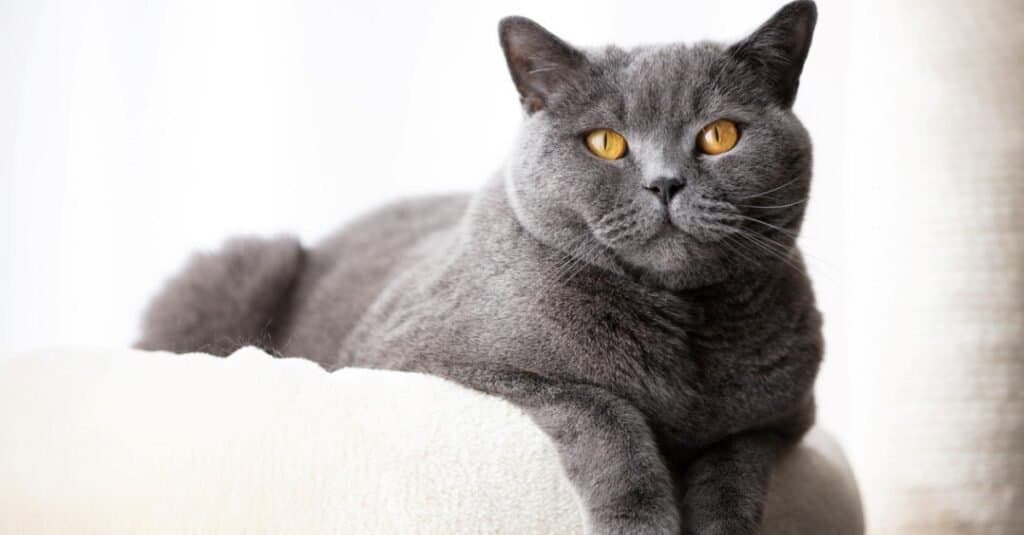
A relatively large cat, the British shorthair surprisingly does not shed as much as you would think!
©iStock.com/NiseriN
The British shorthair is easily recognizable by its unique appearance. These cats are medium to large in size, measuring anywhere between 22 and 25 inches long and weighing between 7 and 17 pounds. Notably, they tend to have a strong bond with their families.
However, when it comes to showing affection, don’t expect too much in the way of cuddling. Furthermore, being primarily indoor creatures, their calm disposition makes them susceptible to outdoor dangers, maybe from animals like coyotes or raccoons.
In terms of their fur, British shorthairs sport short and dense coats. Interestingly, this fur is not double-coated or woolly in nature. While blue might be the most common color you’ll see, there’s actually a wide range of colors and patterns in a British shorthair, including solid, tortoiseshell, and bicolor, among others.
Their appearance, notably their round head, large round eyes, and sturdy body gives them a teddy-bear-like charm and cuteness. Even with such thick fur, shedding is surprisingly not a huge issue for them, and that’s thanks to the fact that these cats have no undercoat! For their coat’s optimum health, you’d do well with a brushing session once a week. Even if shedding isn’t rampant, it still helps.
3. Bengal Cat
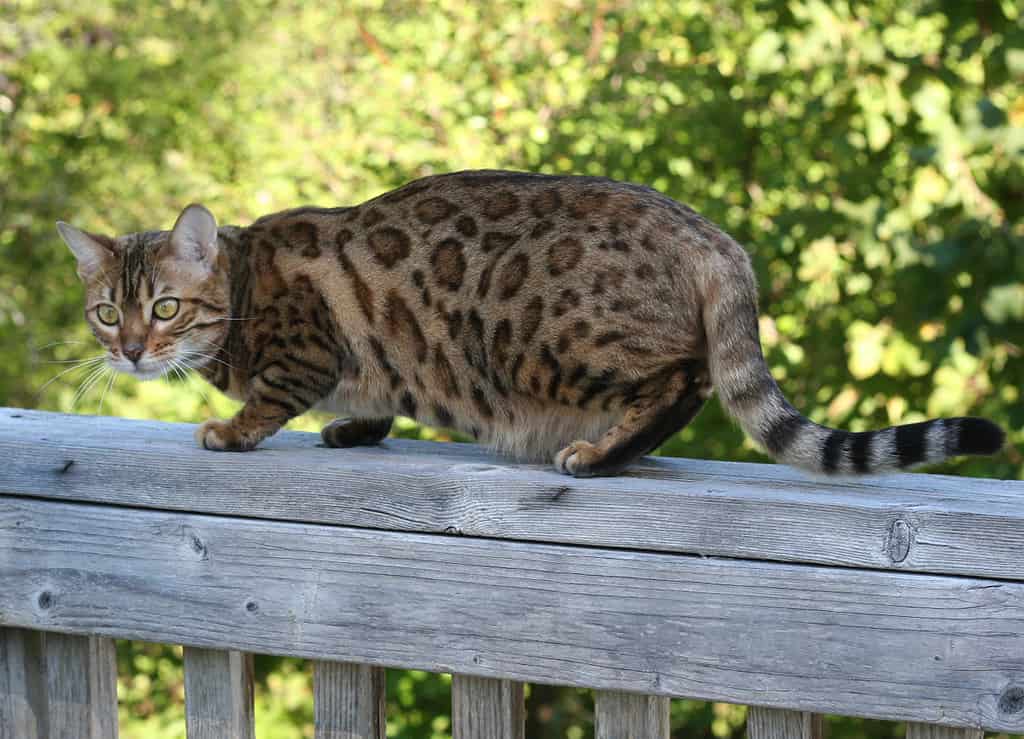
A relatively new breed of cat, the Bengal cat is a domestic breed that emerged in the United States and is marked with a sort of wild charm and look. Notably, this cat breed has beautiful leopard-like spots or rosettes. This distinctiveness in its coat can be traced back to its ancestors, which include the Asian leopard cat and some domestic felines, notably the Egyptian Mau.
Bengal cats, being medium to large in size, boast a muscular, long body complemented by a wide head, pronounced cheekbones, and large, round eyes. Averaging a weight between 6 to 15 pounds, they stand at a height ranging from 13 to 16 inches. Their behavior, it’s worth noting, is a mix of energetic and intelligent with a dash of affectionate curiosity. Bengals are very loyal, but keep in mind that they need to run and jump around to be content.
While not fully hypoallergenic, Bengals shed very little; this trait is an absolute blessing from a grooming and cleaning standpoint. The coat they flaunt is dense and short, decorated with bold patterns that can be seen in various colors, including but not limited to brown, silver, and snow.
Soft as bunny hair, their fur is exceptionally gentle to the touch. Also, those unique rosette markings mirror the patterns on wild cats like leopards, jaguars, and ocelots, and they’re the only cat breed to have this patterning. This gives the Bengals an edge in the domestic cat world. Their majestic coat doesn’t demand specialized care, and, coupled with their lively nature, this aesthetic appeal is a magnet for cat enthusiasts around the world.
4. Devon Rex
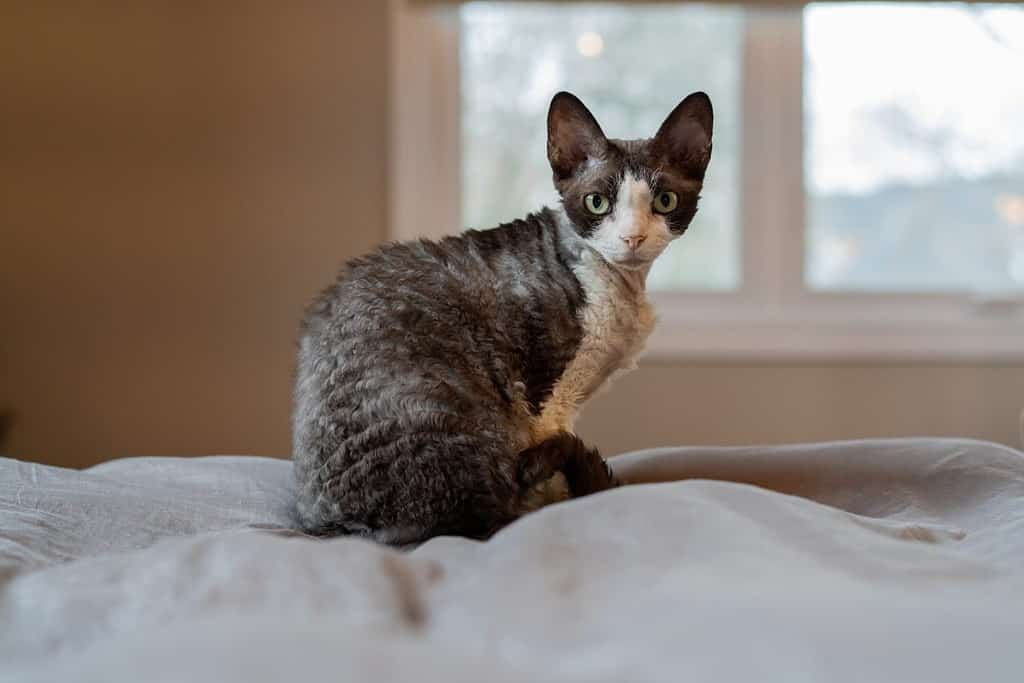
The Devon rex is a small to medium cat that rarely sheds, making them almost hypoallergenic.
©Heather Raithby Doyle/Shutterstock.com
A small to medium-sized cat, the Devon rex is a breed that generally weighs in the range of 6 to 9 pounds and stands at a height between 10 and 12 inches. This cat breed usually measures around 15 to 18 inches long. A slender body, high cheekbones, an extended neck, large ears, and even bigger eyes shape this breed’s distinct appearance, evoking an almost elfin or otherworldly look.
The Devon rex is a relatively popular cat for people prone to allergies, as this cat breed has a very minimal shedding pattern. Interesting, their coat is what catches the eye. Curly and incredibly soft, this short coat brings the “rex” into their name, a nod to the wavy nature of their fur. Just like canine curly-haired breeds, the Devon rex barely sheds, making them almost hypoallergenic.
Depending on the individual cat, the fur might present itself as a tousled ensemble of curls or have a feel resembling thin suede. Despite its delicate appearance, the fur is quite fragile. So, if you have a Devon rex or are thinking of getting one, try not to brush its fur too often, as it could damage their coat.
5. Cornish Rex
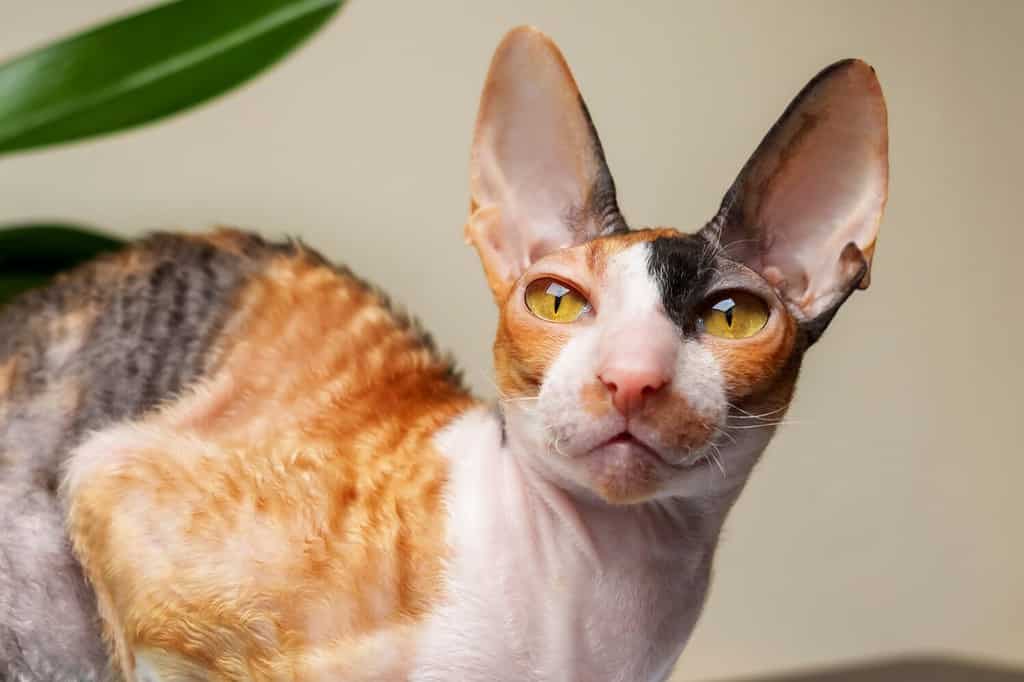
The Cornish rex is a breed that leans on the hypoallergenic side as it doesn’t shed very much!
©Pavel105/Shutterstock.com
Another cat that hails from the United Kingdom is the Cornish rex. A medium-sized cat, this breed tips the scales between 6 and 10 pounds and measures around 8 to 12 inches tall. These cats can potentially enjoy a lifespan ranging from 10 to even 20 years! It’s their personality that often draws attention to the Cornish rex. Extroverted, affectionate, and comically inquisitive, these felines have been painted with descriptions like active, sociable, and notably playful. So, if you’d like a cat breed that doesn’t shed that will retain its kitten-like energy, the Cornish rex is a great pick!
This affable nature, in fact, makes them excellent companions, seamlessly bonding with humans and blending well with other cats and even dogs. They are often referred to as: “the Greyhound of cats,” a nod to their elegant and regal appearance.
Their coat leans on the hypoallergenic side, shedding remarkably less, a feature allergy sufferers might find endearing. However, as usual, a quick reminder: just because they don’t shed much doesn’t mean grooming is off the table. Unlike other breeds, the oils on their skin don’t spread very well, leading to occasional bathing necessities, including some ear and paw cleaning.
6. Bombay
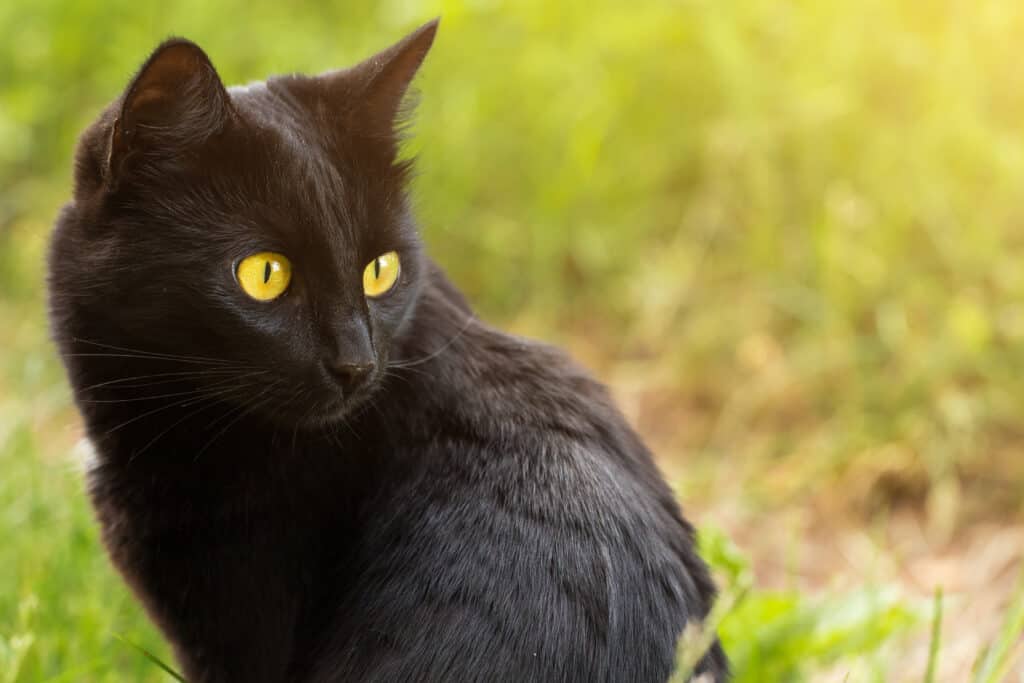
Bombay cats are a beautiful shiny black color with striking copper-gold eyes.
©Viktor Sergeevich/Shutterstock.com
Named after the Indian city of the same name, the Bombay hails from the US and is a medium-sized feline. These felines can weigh up to 15 pounds and can stretch up to 13 to 20 inches long. Bombays look almost like mini black leopards. Boasting a muscular physique, the Bombay breed has a shiny, solid black short coat. This coat is further accentuated by its distinct copper-golden eyes. Interestingly, there are two kinds of Bombay cats: the American and the British Bombay. Depending on their diet and care, these cats can have a lifespan between 9 and a surprising 20 years. But on average, these cats tend to live up to 15 years of age.
Like other cats, the Bombay isn’t technically hypoallergenic. But like the other cat breeds on this list that “don’t shed,” they do have a tendency to shed very little. This makes them somewhat suitable for those with sensitivities to pet dander. Now, one thing that stands out about the Bombay cat is its fur. It’s short yet incredibly sleek and fits tight to the body.
The black coat is undeniably glossy, almost mimicking the allure of a black panther. And while the fur is inherently low-maintenance due to its shortness and minimal shedding, some regular grooming wouldn’t hurt. A weekly brush is all it would need! In fact, a regular brush would keep the coat mat-free and in prime condition.
7. Russian Blue
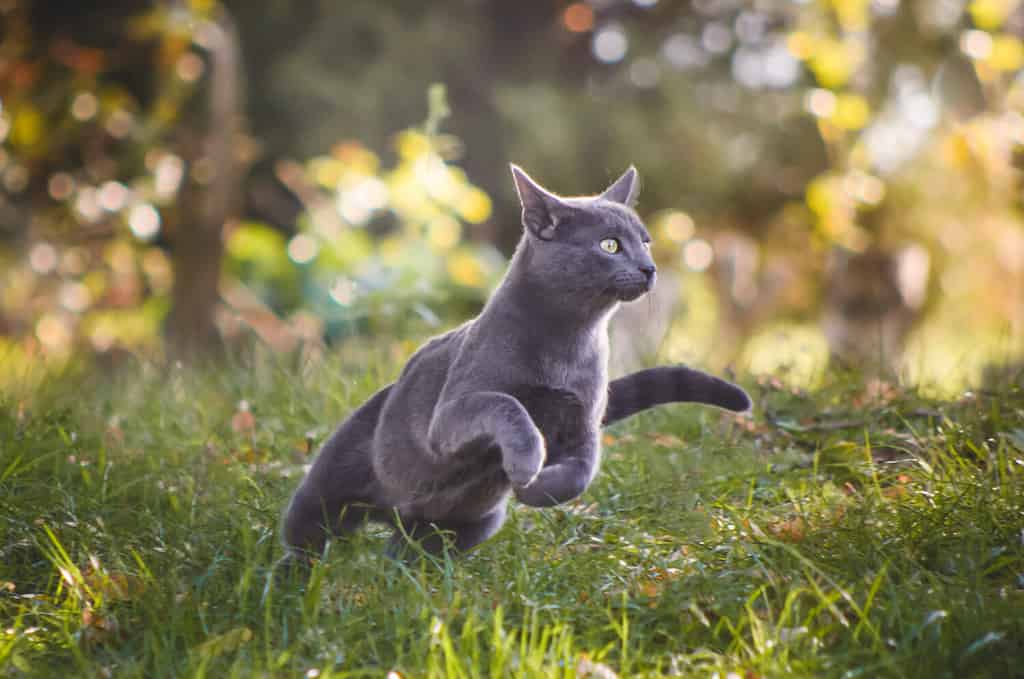
One of the more popular cat breeds known for its low shedding tendencies is the Russian blue.
©ddisq/Shutterstock.com
A favorite cat breed around the world is Russian blue, which originates from the port of Arkhangelsk in Russia. By the 1860s, sailors had taken them all the way to Northern Europe and Great Britain. This cat breed, known for its blue-gray, plush, short coat, boasts a refined physique. Male Russian blues can weigh between 10 and 12 pounds, while the females, a bit smaller and lighter, range from 7 to 10 pounds.
As for their size, Russian blues generally grow to around 10 inches tall and 15 to 18 inches long. Their head, interestingly wedge-shaped, is complemented by large ears in the shape of a triangle and almond eyes of vibrant green. However, when they’re kittens, these eyes start as a bright yellow instead!
Their coat sheds little, which makes them a popular breed amongst those with mild cat allergies. Thankfully, this also means this cat requires minimal grooming. Simply a brush every week or two should suffice; this will help maintain the fur’s plush nature and, more importantly, control shedding. The Russian blue has a dense double-layered coat; the inner layer is thick and soft, while the outer layer has a plush feel and a silvery tip, giving this breed a beautiful shimmer.
Not only does this double coat enhance their appearance, but it’s also a nod to their origins. This dense coat protected this cat from the chilly Russian climates. These cats are pretty clean by nature. Their fur won’t make much of a mess around your home, making them a neat choice for potential pet owners, especially if grooming and constant cleaning aren’t something they are super excited about.
8. Sphynx
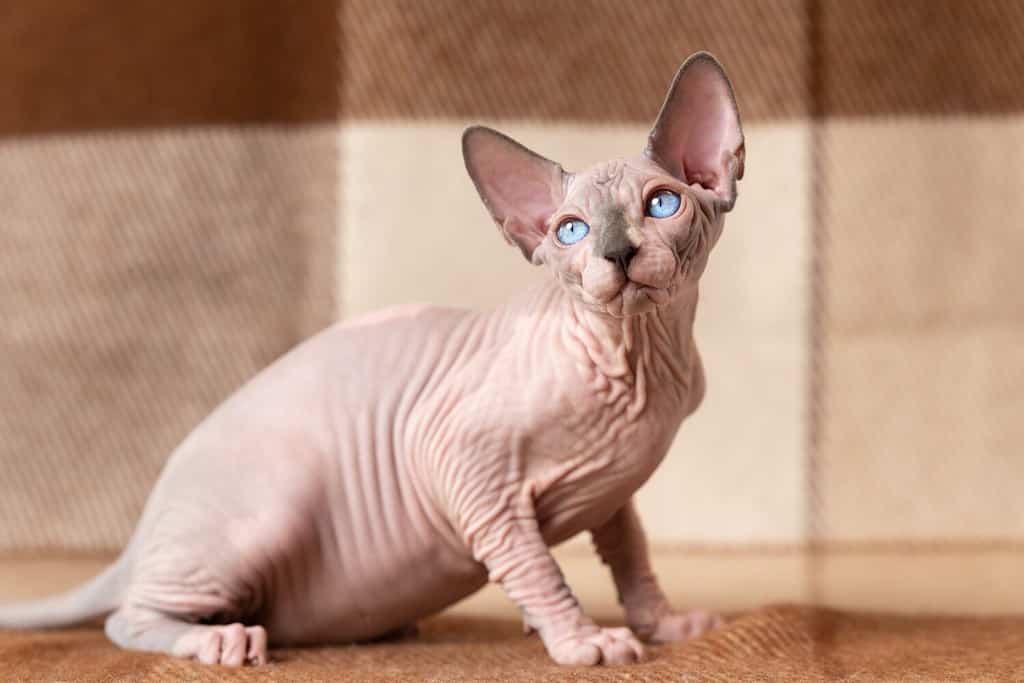
The Sphynx is the most famous cat breed that doesn’t shed.
©Alexander Piragis/Shutterstock.com
Of course, no list of the cat breeds that don’t shed is complete without a nod to the Sphynx! The Sphynx is a medium-sized cat breed, growing to around 8 to 10 inches tall, easily recognizable by its hairless appearance. Yes, hairless! Typically, both males and females weigh less than 12 pounds. With a sleek and muscular frame, their appearance is marked by a triangular head, large bat-like ears, and eyes that are set widely apart.
When it comes to skin color and patterns, it can be akin to what you’d find on furred cats, such as solid, tabby, or even tortoiseshell. Sphynx cats have a preference for multiple meals throughout the day. This could be anything from raw meat, kibble, or raw fish without bones. However, make sure to stick to lean meat such as tuna, salmon, turkey, and chicken in order to maintain their physique! Their dietary quirks are interestingly tied to their lack of fur, necessitating more calorie consumption to maintain warmth.
Now, while the sphynx cat might seem hairless and some may be entirely bald, others sport a touch of peach fuzz. The texture is like touching fine suede. These cats won’t shed much due to their minimal (or nonexistent) fur, but oil buildup on the skin means grooming needs are heightened. And a myth to bust: they’re actually not fully hypoallergenic, despite the absence of a full coat.
9. Peterbald
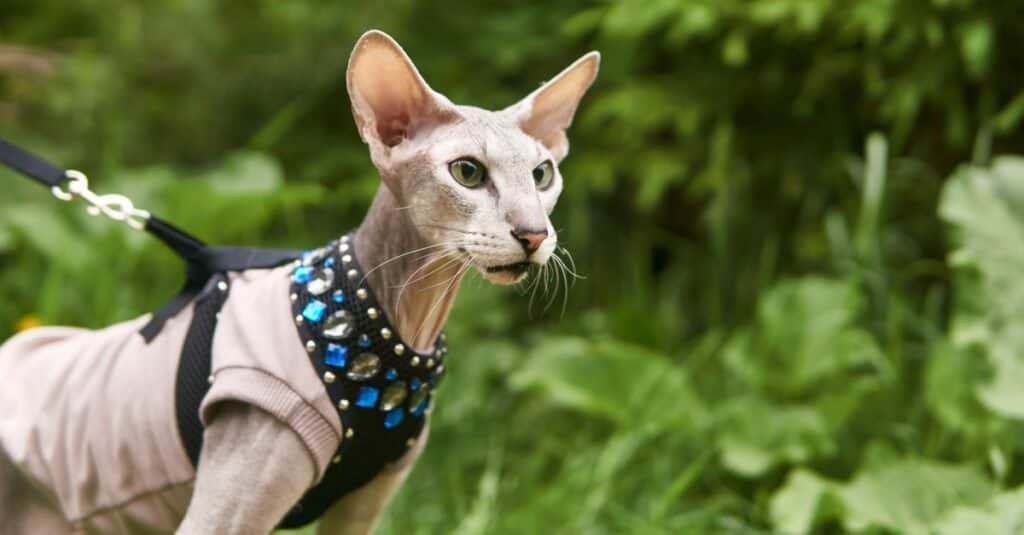
Peterbald cats are generally bald, and they can come in a range of skin colors.
©iStock.com/Евгений Харитонов
Another cat to add to this list of cat breeds that don’t shed is the Peterbald. This relatively new cat breed finds its roots in Saint Petersburg, Russia. It emerged from the crossbreeding of an oriental shorthair and a Donskoy cat. Exhibiting an elegant demeanor, Peterbalds come with slender and athletic bodies, accompanied by long legs and a notably long triangular snout. Weighing between 6 to 10 pounds, these cats can live up to 12 to 15 years. In terms of their character, Peterbalds are often described as friendly, interactive, and notably sharp.
Interestingly, Peterbalds have very distinctive fur. The fur can come in various types, including bald, peach fuzz, or very short hair. In terms of color, these cats can be found in shades like white, black, red/orange, gray, fawn, and even lilac. The patterns range from solid and bicolor to tabby and colorpoint. The complexity of their coat can change throughout their lifetime, making them a standout among feline breeds in terms of fur variety.
While you won’t have to worry too much about shedding when it comes to the Peterbald, if you have a hairless cat, your cat might benefit from an occasional bath or wipe.
10. Oriental Shorthair
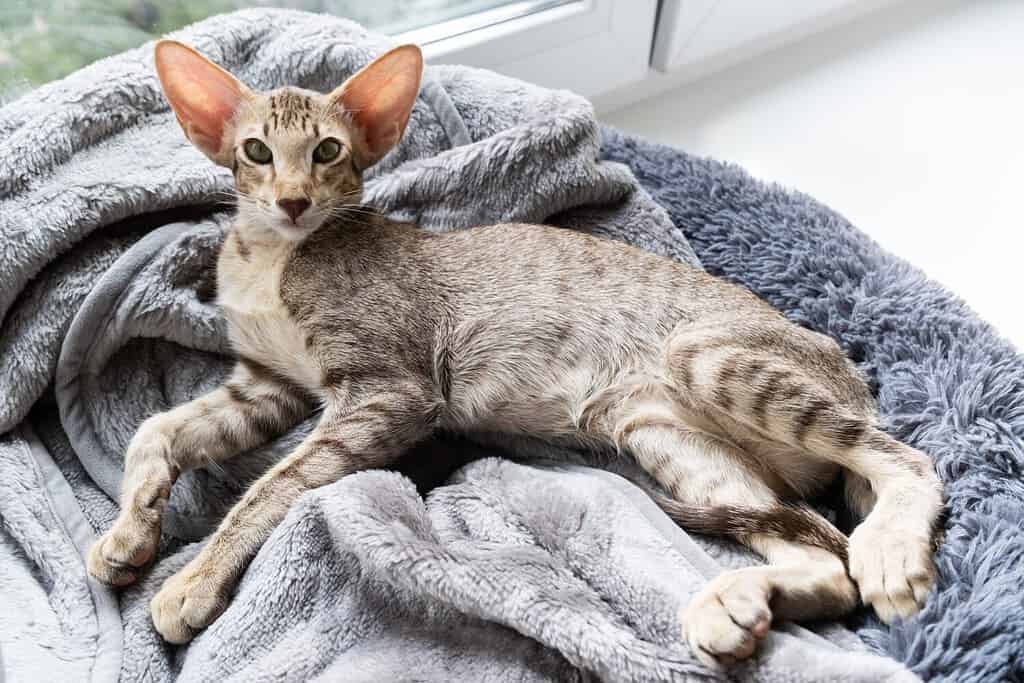
An elegant cat breed that barely sheds, the oriental shorthair has large, almond-shaped eyes.
©VittoriaChe/Shutterstock.com
The oriental shorthair cat is a graceful and elegant breed that is closely related to the Siamese. The spectrum of its color variations is vast, with a staggering count of over 300 colors, giving it the apt nickname, the “rainbow cat.” Oriental shorthairs are slender and nimble and weigh between 6 to 12 pounds. Their lifespan usually stretches from 12 to 15 years.
Personality-wise, oriental shorthairs are known for their vocal and interactive nature. They are incredibly social cats that thrive on human interaction, making them wonderful companions for those who are after an active and engaging relationship with their feline companions.
Their sleek bodies are adorned with short, fine fur that lies close to their skin, giving them a polished and refined look. They also boast large, expressive almond-shaped eyes and large, pointed ears. Their coat is of the short to medium variety, sleek, and very fine in texture. For those battling allergies, the oriental shorthair emerges as a favorite; their short coat plays a pivotal role here. To manage their minimal shedding, all it takes is a brush on a weekly basis.
11. American Shorthair (Honorable Mention)
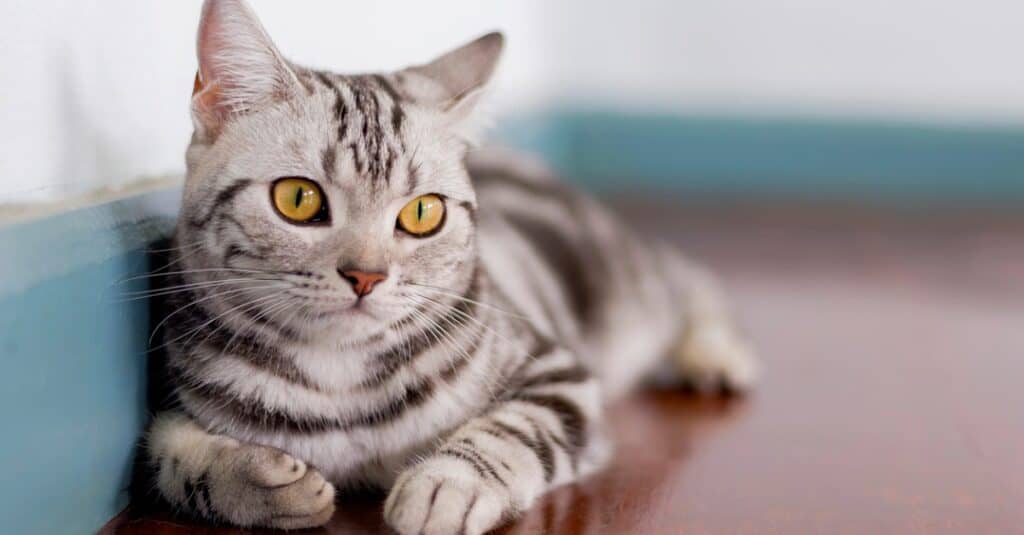
While American shorthairs don’t typically shed less than other cats, they do require less grooming overall!
©iStock.com/kla3950
Despite its name, the American shorthair actually originated in Europe, although its formal breed development took place in the United States. This popular breed is medium to large in size, weighing between 10 to 15 pounds and measuring between 8 and 10 inches tall. In terms of length, the American shorthair is generally around 12 to 15 inches long. Known for their friendly nature, these cats also have a sturdy build. When it comes to coat colors, you’ll find a wide assortment, with shades of white, silver, black, cream, blue, brown, and red. In fact, this cat can come in 80 different colors! And while tabby is a popular pattern, the American shorthair also comes in calico, tortoiseshell, bicolor, and solid. The silver tabby is a crowd favorite.
Their fur is short and thick. Notably, it’s light on the shedding scale, making the American shorthair demand less grooming effort compared to their long-haired breeds. For most, a brush once a week keeps them looking their best. One major advantage of this breed is their fur’s simplicity and resistance to matting or tangling, a feature many cat owners appreciate. However, with all that said, the American shorthair is not necessarily a cat that doesn’t shed; it’s just much less maintenance, so it deserves a spot on this list!
Summary of Cat Breeds that Don’t Shed (or Barely Shed)
| Number | Cat Breed | Fur Type Description | Coat Length | Unique Features |
|---|---|---|---|---|
| 1. | Siamese | Short, glossy, fine, adheres to the body with no undercoat | Short | Pointed color scheme, blue eyes |
| 2. | British Shorthair | Short, very dense, not double coated or woolly | Short | Crisp fur, plush texture |
| 3 | Bengal | Soft, short, rabbit-like fur, single layer | Short | Glittery fur |
| 4. | Devon Rex | Soft, wavy, lacks guard hairs | Short | Curly appearance |
| 5 | Cornish Rex | Short, curly, extremely fine, lacks guard hairs | Short | Soft, plush feel |
| 6. | Bombay | Short, sleek, smooth, satin-like texture, jet-black color | Short | Glossy appearance |
| 7. | Russian Blue | Double coat: soft, downy undercoat and even-colored outer layer with silver tips, plush and soft | Short | Silvery blue-gray color |
| 8. | Sphynx | Nearly hairless, ranging from completely bald to peach fuzz, fine, downy, suede-like texture | Extra-short | Wrinkly skin |
| 9. | Peterbald | Varies from hairless, flock, chamois, brush, straight, to fine peach fuzz. Coat type can change over time | Varies | Variety of coat types |
| 10. | Oriental Shorthair | Short, close-lying, sleek, smooth, very fine and glossy | Short | Over 300 color variations |
| 11. | American Shorthair | Short, dense, rough texture, lies close to body | Short | Many colors and patterns |
The photo featured at the top of this post is © VittoriaChe/Shutterstock.com
Thank you for reading! Have some feedback for us? Contact the AZ Animals editorial team.




